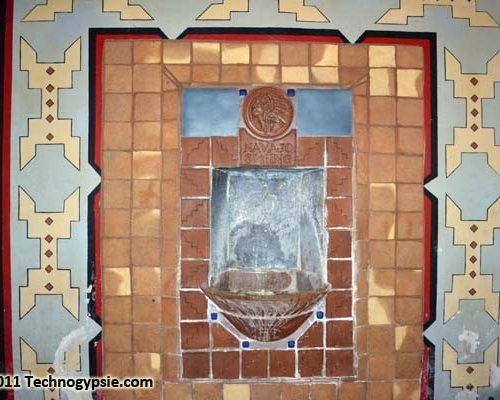Navajo Spring
Manitou Springs, Colorado, USA
Just off of main street in historic Manitou Springs, at the back of the popcorn and candy store in front of the amusement arcade, coming out of the wall in a decorated font is a natural soda spring that is one of 7 popular natural springs that put this town on the map. Originally visited by Native American Indians who sought their healing and spiritual powers whom some believed were gifted by the great spirit called Manitou.
They were then frequented by white Euro-American settlers, who pushed the tribes out and commercialized the area. It is because of the commercialization of this particular spring is the one where legend has it the Utes placed a curse on all whites that the westerners can never have a successful business in this place. By the late 1880s, the westerners built a large bathhouse and spa, as well as a bottling plant on this former location, but did not succeed. The waters however were famous throughout American in that time and place.
The spring waters are fissured up through rock fractures from the rainwater and snowmelt coming from Pikes Peak. Water reaching the depths become heated and mineralized, flowing up through the Ute Pass fault zone, into limestone caverns that carbonate them and tapped into by natural springs or wells. Each spring in the area has its own distinct taste and flavor. This particular spring originally had a bowl-like concretion of calcium carbonate that was large enough to dip or wash oneself in.
From 1871-1972, Chief Joseph Tafoya – Chief Joe “LIttle Deer” and his family came to this spot to do authentic Indian dances and songs from the Tewa tribe of the Pueblo Reservation of Santa Clara, New Mexico. In 1889 Jerome Wheeler built a 3 story bottling plant east of the arcade and used these waters to bottle up to 5,000 gallons of water a day selling it throughout the world as table water of the popular non-alcoholic Giner Champagne. After the collapse of the plant, the spring fell into abuse and was restored in 1991 by Manitou’s residents and donors.
- Navajo Spring: “Chief Joseph Tafoya – Chief Joe ‘Little Deer’ 1891-1972: Generations of the Tafoya family have presented authentic Indian dances and songs on this site and at the Manitou Cliff Dwellings Museum since 1925. The Tafoya Family Dancers are members of the Tewa tribe from the Pueblo Reservation of Santa Clara, New Mexico, and descendants of the ancient Puye Cliff Dwellers. For 15 years, Chief Joseph Little Deer served both as governor of the Santa Clara Reservation and Chairman of the All Pueblo Indian Council. He introduced a democratic form of government on the reservation, opened his home to orphaned Indian children, and worked tirelessly to improve the living conditions of his people. Chief Little Deer married Petra Suazo, a great-niece of Cheif Manitou so named for his active promotion of Manitou Springs at the turn of the century. Chief Manitou danced for 20 summers at the Cliff Dwellings Museum. Navajo Spring is one of the seven natural soda-type springs that led to the settlement of Manitou. The early French trappers named the bordering creek “Fountaine qui Bouille”, the Boiling Water. Mineral deposits containing large amounts of carbonate of lime created a natural basin where the Indians bathed their sick and wounded. The white mineral basin now is hidden under the arcade floor. In 1889, Jerome Wheeler built a 3-story bottling plant east of the arcade and used Navajo Spring for bottling up to 5000 gallons of water a day. The water was sold worldwide as table water of the popular non-alcoholic Ginger Champagne. Navajo Spring was restored in 1991 by generous assistance from various donors” ~ sign outside the Spring.









